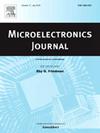恒流 LED 驱动器的温度补偿技术
IF 1.9
3区 工程技术
Q3 ENGINEERING, ELECTRICAL & ELECTRONIC
引用次数: 0
摘要
本文介绍了使用台积电 0.35 μm 混合信号 2P4M 聚酰亚胺 3.3V/5V 工艺的 LED 驱动芯片的设计与实现。主要重点是设计温度补偿电路,以减少 LED 照明的变化。基于片上温度传感电路,LED 驱动电流可在不同温度下自动补偿。我们采用压控振荡器(VCO)作为温度计。当温度升高时,VCO 的频率会降低。我们采用数字编码器对温度信息进行编码。然后利用这些数字数据自动控制开关,调整电流以补偿 LED 电流因温度变化而产生的变化。所有功能都集成在一个面积约为 2.2 平方毫米的硅芯片上。温度补偿后,驱动电流的误差率可从 14% 降至 0.7%。本文章由计算机程序翻译,如有差异,请以英文原文为准。
A temperature compensation technique for constant current LED driver
This paper presents the design and implementation of an LED driving chip using TSMC's 0.35 μm Mixed-Signal 2P4M Polycide 3.3V/5V process. The main focus is on designing temperature compensation circuits to reduce variations in LED lighting. Based on the on-chip temperature sensing circuit, the LED driving current can be automatically compensated under various temperatures. We employ a voltage-controlled oscillator(VCO) as a thermometer. The VCO's frequency decreases when the temperature increases. Digital encoders are employed to encode this temperature information. This digital data is then used to automatically control switches, adjusting the current flow to compensate for LED current variations due to temperature changes. All functions were integrated to a silicon chip with about 2.2 mm2 area. With temperature chamber testing, the range from −20 °C to 120 °C, the results show that the error rate of the driving current can be reduced from 14 % to 0.7 % after temperature compensation.
求助全文
通过发布文献求助,成功后即可免费获取论文全文。
去求助
来源期刊

Microelectronics Journal
工程技术-工程:电子与电气
CiteScore
4.00
自引率
27.30%
发文量
222
审稿时长
43 days
期刊介绍:
Published since 1969, the Microelectronics Journal is an international forum for the dissemination of research and applications of microelectronic systems, circuits, and emerging technologies. Papers published in the Microelectronics Journal have undergone peer review to ensure originality, relevance, and timeliness. The journal thus provides a worldwide, regular, and comprehensive update on microelectronic circuits and systems.
The Microelectronics Journal invites papers describing significant research and applications in all of the areas listed below. Comprehensive review/survey papers covering recent developments will also be considered. The Microelectronics Journal covers circuits and systems. This topic includes but is not limited to: Analog, digital, mixed, and RF circuits and related design methodologies; Logic, architectural, and system level synthesis; Testing, design for testability, built-in self-test; Area, power, and thermal analysis and design; Mixed-domain simulation and design; Embedded systems; Non-von Neumann computing and related technologies and circuits; Design and test of high complexity systems integration; SoC, NoC, SIP, and NIP design and test; 3-D integration design and analysis; Emerging device technologies and circuits, such as FinFETs, SETs, spintronics, SFQ, MTJ, etc.
Application aspects such as signal and image processing including circuits for cryptography, sensors, and actuators including sensor networks, reliability and quality issues, and economic models are also welcome.
 求助内容:
求助内容: 应助结果提醒方式:
应助结果提醒方式:


